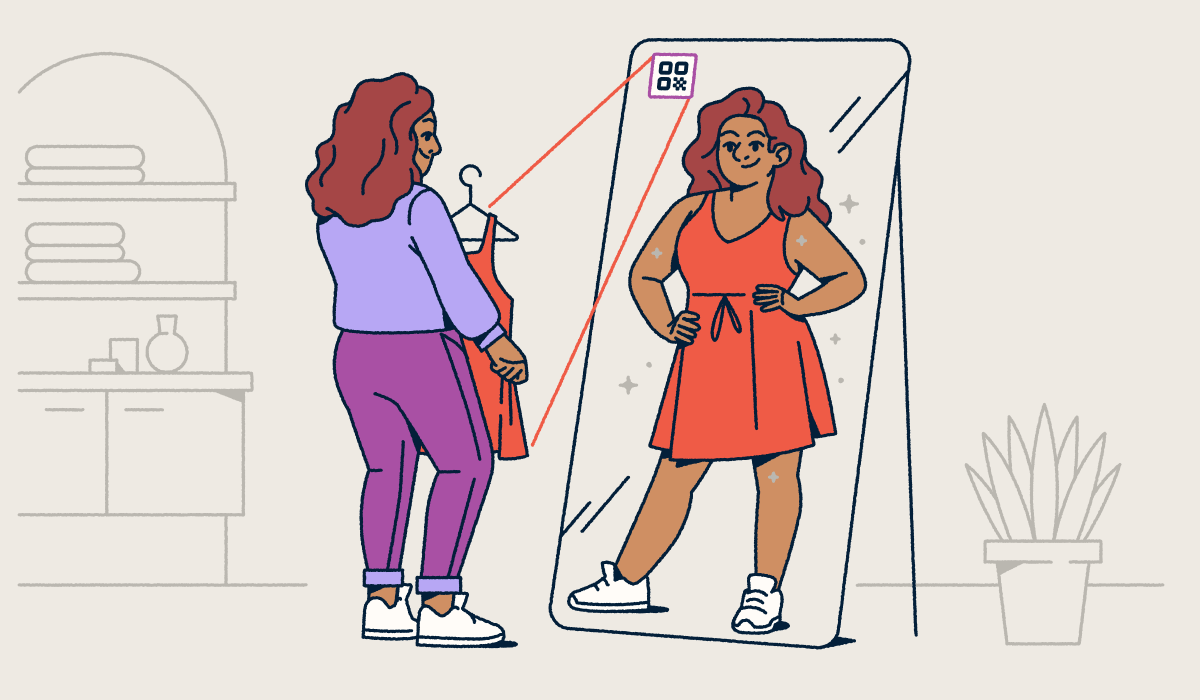It’s been a tough stretch for the retail landscape. Beloved chain stores, department stores, and even long-established brands are closing their doors at a growing rate. And it’s not just small businesses going out of business. It’s major retailers with national reach.
Earlier this year, Walgreens announced plans to close more than 500 locations. Macy’s shared its decision to shutter 66 stores, with 150 total closures expected by 2026. Brands like Joann, JCPenney, Kohl’s, and Walmart are also scaling back their brick-and-mortar footprint.
So what’s driving these closures? And what can retailers do to stay competitive? Below, we’ll look at the biggest trends behind the shift and share retail marketing strategies to help stores adapt and thrive.
Note: The brands and examples discussed below were found during our online research for this article.
3 key reasons retail stores are closing
Research suggests that more than 15,000 stores across the US will close in 2025—that’s more than double the 7,000 that shut down last year. Closed stores aren’t the result of just one problem. They reflect a mix of overlapping pressures that continue to reshape how retail stores operate.
Let’s take a closer look.
1. Economic pressure and inflation
One of the main reasons so many brick-and-mortar stores are shutting down in 2025 is a combination of economic pressure, rising interest rates, and ongoing inflation. More than half of Americans say they’re in “fair” or “poor” financial shape, and one in five are struggling to pay their rent or mortgage. That means less disposable income to spend in retail stores.
To make matters worse, inflation and impending tariffs are driving up the cost of goods. Grocery prices have jumped 23% since 2021, and the cost of electronics could rise by up to 68%, depending on the category.
With prices climbing and financial stress mounting, consumer confidence is down. People are spending less, and the retail space is feeling the effects.
2. Changing consumer habits and the rise of online shopping
Another major driver behind the liquidation of retail stores is the ongoing shift toward online shopping, especially among millennials and Gen Z. When consumers choose to spend, many head straight to online retailers like Amazon and Temu. Why? Because ecommerce often means better prices, more variety, and that all-important sense of personalization.
In today’s data-driven world, consumers have sky-high expectations for the brands they buy from. In fact, 88% say the experience a company provides is just as important as its products or services. Online, it’s easy to meet those expectations. With data analytics, loyalty programs, and marketing technology, retailers can personalize the customer experience at scale.
While these strategies are possible in-store too, many retailers struggle to deliver the level of personalization customers expect.

3. Strategic missteps and the failure to pivot
Beyond economic pressures and shifting consumer habits, mismanagement and strategic missteps have also contributed to the downfall of many retailers. One of the most common? Treating physical stores as purely transactional spaces.
Today’s consumers expect more. Shopping isn’t just about function—it’s about experience. Research even shows a direct link between store revenue and how fun shoppers perceive the in-store experience to be. The traditional store layout isn’t enough anymore. It needs to be engaging, interactive, and digitally enhanced.
Take Lush, for example. The hybrid retail brand’s newest stores are far more than just places to buy soap. They’re digital playgrounds. With the #LushLabs app, customers can scan bath bombs to explore ingredients and properties, and they can even watch visuals of how the product will fizz and dissolve in their tub. It’s the kind of experience that drives foot traffic and earns shares online.
But Lush is still an exception. Many retailers are falling behind, unsure how to reimagine their physical stores for today’s digital-first customer.
How retailers can survive and thrive
The retail industry is navigating a period of major change. Technology, evolving consumer expectations, and inflation are putting real pressure on physical stores. But pressure can also create opportunity.
72% of total US retail sales will still happen in physical stores by 2028. Customers aren’t walking away from brick-and-mortar, they’re just becoming more selective. Value, experience, and personalization are rising to the top of their priority list.
Retailers that adapt to these expectations have a chance to stay competitive and grow. The key is building smart, connected strategies that meet customers where they are.
Here are the retail marketing best practices every brand should know.
Make improvements to your customer experience
Today’s shoppers have more choices than ever, but 67% say they prefer to stay loyal to a single brand. So, how do you earn that loyalty? By delivering in-store experiences that feel seamless, personal, and rewarding.
That goes beyond offering a basic loyalty program. Retailers need to recognize and engage customers at every touchpoint, especially inside the store. Too often, the in-person shopping journey ends at the register. A customer makes a purchase, walks out, and never hears from the brand again. That’s a missed opportunity.
One of the simplest ways to improve this experience is through SMS. Text messaging is a direct, effective way to stay connected. It lets you follow up after a visit, send personalized promotions, collect feedback, or deliver timely offers when a customer is nearby. It’s a simple tactic with the power to turn one-off visits into lasting relationships.

Bridge your physical store and online destinations
The most forward-thinking retailers are embracing a “phygital” approach, blending online and offline touchpoints to create a seamless customer experience.
The goal is to give customers flexibility. Phygital retail allows shoppers to interact with your brand however and wherever it’s most convenient—whether they want to browse in-store and buy online, order from home and pick up later, or get real-time recommendations while standing in front of a display.
QR Codes offer a simple, low-risk way to kick-start your phygital strategy. Here’s how to use QR Codes in retail:
- Detailed product info: Add QR Codes to product displays so customers can scan with their smartphones to access landing pages with reviews, how-to videos, ingredient lists, or sizing guides, helping them feel more confident about their purchase.
- In-store ordering: When an item is out of stock, a QR Code can direct customers to your website to place an order for home delivery or in-store pickup, helping you save a sale.
- Full catalog access: If your store has limited space, QR Codes can link to your complete online inventory, allowing shoppers to browse and buy beyond what’s on the shelves.
These aren’t just theoretical use cases either. Brands like Rad Power Bikes are already using Bitly Codes to bridge the gap between physical retail and digital experiences. Across its store locations, Rad Power Bikes places codes that shoppers can scan to explore products, accessories, and how-to content online, right from the showroom floor.
“Using QR Codes helps us have a more consistent customer experience across channels. It gives us the opportunity to seamlessly direct people from a retail store experience to our brand website, which is an important part of the customer journey.”
– Lauren Rothering, Senior Brand & Product Marketing Manager at Rad Power Bikes
Optimize your store layout and touchpoints
As we’ve noted, experiential retail marketing is essential in today’s competitive landscape. But not every retailer has the resources to overhaul their in-store experience with augmented reality, AI, or other cutting-edge tech.
The good news? You don’t need a massive budget to start making improvements. Here are a few ways to enhance your store layout and touchpoints:
- Zone design: Creating distinct zones within your store to make shopping feel more like a journey. Brands like Søstrene Grene and Tiger Tiger use themed zones to guide customers through different sections and spark discovery.
- QR Codes for retail marketing: Place QR Codes on endcaps, product displays, or signage to make the experience more interactive. Link them to how-to videos, product demos, or usage tips to show shoppers how items work in real life.
- Brand storytelling: Use visuals to immerse customers in your brand. Think art, projections, or video displays that communicate your values and personality.
- Community spaces: Make your store a destination, not just a place to shop. Just look at Eataly: part market, part restaurant, and part cultural center. Its locations regularly host cooking classes, wine tastings, and communal dining experiences that draw customers in for more than just groceries.

Prioritize data-driven insights
In 2025, retailers of all sizes need to tap into customer insights to guide decision-making. The more you understand how people shop, what they love, and where they engage, the better positioned you’ll be to deliver experiences that keep them coming back.
And you don’t need a complex tech stack to start learning more about consumer behaviors. QR Codes can close the gap.
Take Daily Harvest. When the brand expanded its farm-frozen offerings into Kroger stores across the US, it used scan data from Bitly Codes on in-store freezer wraps to track which locations were generating the most engagement. With insights from Bitly Analytics, the team was able to pinpoint high-performing regions, adjust local marketing, and fine-tune their in-store strategy in real time.
That’s just one example of how QR Codes can fuel smarter decisions. Other use cases include:
- Measure campaign performance: Use campaign-specific QR Codes on signage, packaging, or flyers to see which messages or offers drive the most engagement.
- Test product interest: Add QR Codes to displays for upcoming products, linking to “Notify Me” or waitlist landing pages to gauge demand before investing in inventory.
- Gather customer feedback: Link to short post-purchase survey forms to collect real-time input on service, product quality, or the shopping experience.
- Optimize staffing and store hours: Analyze scan patterns to identify peak engagement times, helping you align staff schedules and store hours with actual demand.
Keep innovating and prepare for the future with Bitly
Retail store closures may be rising, but brick-and-mortar retail isn’t going anywhere. It’s evolving. The players that succeed will be the ones who stay agile, testing new ideas, embracing technology, and rethinking their in-store strategies to meet changing consumer expectations.
Bitly can help you lead that change. With the Bitly Connections platform, you can use Bitly Codes to create seamless phygital experiences that connect your physical store with your digital presence. At the same time, you’ll gain powerful, real-time insights into consumer behavior to guide smarter decisions.
Explore Bitly’s plans and see how easy it is to build connected, customer-first retail experiences.




